Snake egg игрушка как открыть
Обновлено: 06.05.2024
There are approximately 3600 different species of snakes and 70% of these are oviparous, meaning they lay eggs. There are some snakes that may only lay as little as 1 egg or give birth only once every three years. However, there are others that can lay up to 100 eggs at a time and who reproduce once a year.
That is a whole lot of snake eggs. And despite the unbelievable range of diverse characteristics recognizable in different species, the same cannot be said for their eggs.
Learning how to identify snake eggs has many benefits.
For snake enthusiasts, it is a great opportunity to add to your knowledge and feed curiosity. You can look out for eggs and practice identification.
And if you’re not a snake enthusiast, but you live in an area with venomous snakes, then learning to identify the eggs is extremely beneficial.
It will be useful for preventing unwelcome house guests or intruders on your property.
Check out everything you need to know about snake eggs including some really interesting facts, as well as how to identify them.
Table of Contents
Do Snakes Give Live Birth?
The gestation period of a snake can be anywhere between as little as two months to as long as human pregnancy at 9 months. This is dependent on the type of species.
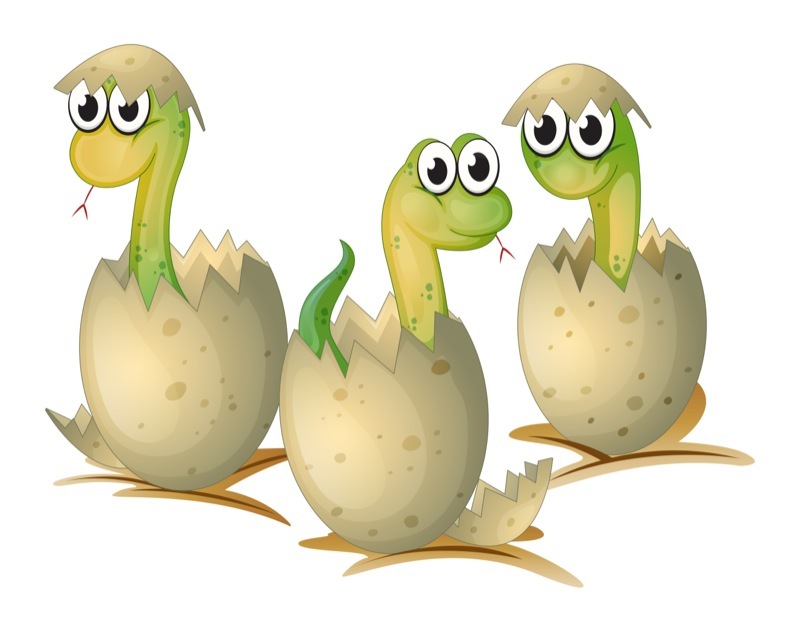
After the gestation period, there are two ways that a snake gives birth. Most people are quick to think that all snakes lay eggs, as this is a common characteristic of reptiles. However, there are snakes that give birth to live young, such as cottonmouths in North America.
There are three main categories of embryonic development in snakes:
- Oviparous snakes lay eggs that require incubation post-laying for the gestation to be completed. 70% of snakes are oviparous, including cobras and adders.
- Ovoviviparous snakes complete the gestation of the egg internally. Once the fetus has fully developed, the babies are born alive and the egg remains in the mother’s body. Snakes such as rattlesnakes have this embryonic mechanism.
- Viviparous snakes don’t make use of an egg at any stage in the reproduction process. The baby develops within the placenta and yolk sac. This is extremely rare and results in live offspring. Boa constrictors and anacondas are viviparous.
The answer, then, is that around 30% of snake species give live birth. It is quite a startling image to think of a tiny vessel of venom entering the world on the hunt.
Identifying Snake Eggs
If you’re wondering whether you’ve picked up a snake’s egg or a bird’s egg, there are a few things you can look out for to aid identification.
Some important aspects to take into consideration are the shape, hardness, and appearance. If you happen to come across snake eggs, you’ll usually find them underground in loose soil or sand.
The female lays them underground, as this acts as a natural incubator. In most cases, she’ll then abandon the eggs. So you don’t need to worry about a protective mama attacking you when she finds you poking around her eggs.
Many snake eggs look strikingly similar to a bird egg and the vast majority of eggs from different species look almost exactly the same.
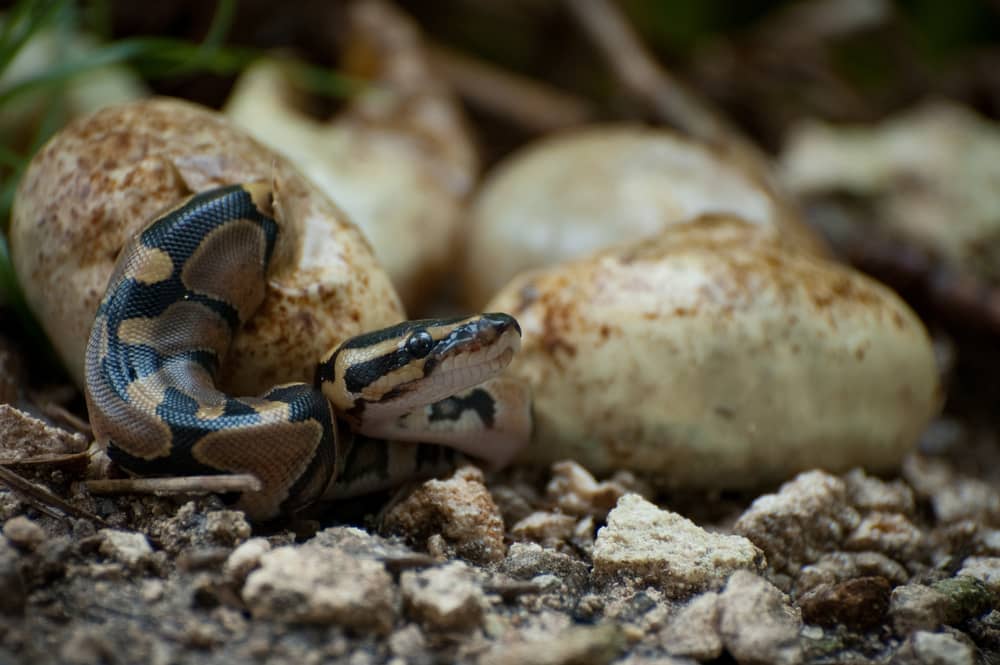
Identifying a snake egg is really a two-part process:
First, figuring out that the egg does indeed belong to a slithering friend and not some other cold-blooded animal or bird.
Second, attempting to identify the species from slight indicators on the egg. However, this is an almost impossible feat unless you happen to be a snake expert or the egg is very rare, with defining physical characteristics.
Are Snake Eggs Soft?
The easiest way to differentiate between a snake egg and bird egg is to note the texture and hardiness of the shell.
Bird eggs are hard, as we know. On the other hand, snake eggs are slightly soft with some give, and the texture is leathery.
This leathery, soft shell of a snake egg decreases the risk of survival significantly.
This means that you need to be gentle and brief when handling the egg for identification purposes.
Reptile eggs can withstand handling for a short time but shouldn’t be held for more than a couple of minutes.
What do Snake Eggs Look Like?
Most snake eggs are oblong.
There are exceptions to this, such as with some African and Asian snakes that lay bumpy eggs that resemble a ginger root.

In North and South America, snake eggs look strikingly similar in shape to the eggs of birds.
It’s safe to say that the color of the eggs will be white, off-white, or beige in color.
If you’ve happened upon a bright blue or green egg, it’s either not a snake egg or it’s a snake egg that is dying. This is caused by mold or an unhealthy embryo, but there’s no hope for the little snake if the egg is blue/green.
How Big are Snake Eggs?
Snake egg size differs according to the type of snake.
It also changes throughout the incubation period as the egg grows alongside the embryo. As the egg draws in water, it increases in size and continues to grow until the snake hatches.
The size of a snake egg can be anywhere from 1 inch to the massive 4 to 5-inch python eggs.
In terms of identification, most eggs that have a rubbery shell and are over an inch big are usually snake eggs. Other reptiles such as lizards tend to lay smaller eggs.
How to Identify a Snake Egg
As mentioned above, you can identify whether it is a reptile egg by noticing the texture and suppleness of the shell.
Once you’ve looked at the shape, color, and texture, the final step in identifying the egg is to examine it under a bright light. This is best when the room is very dark.
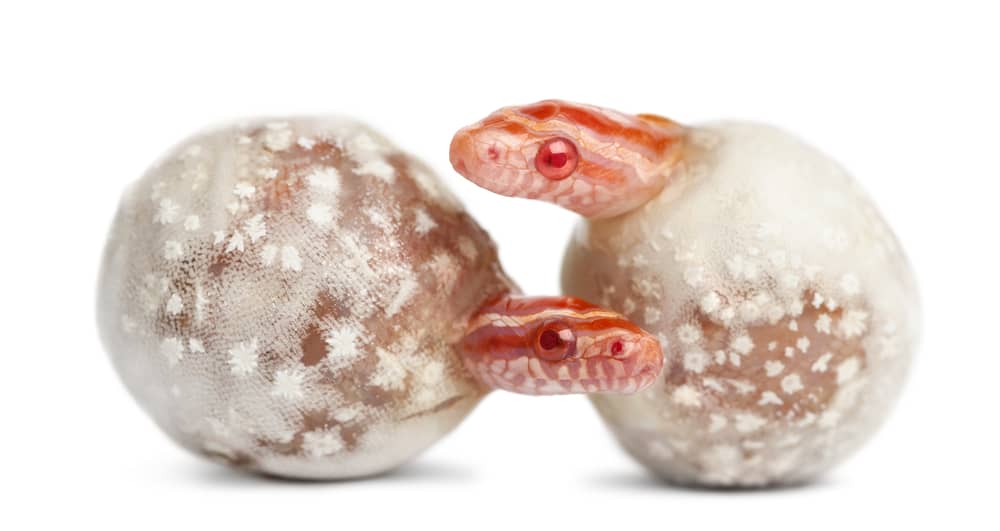
If you lift the egg up towards the light bulb, you’ll be able to see a silhouette of the embryo inside. Look out for a round-shaped embryo as this indicates that it is a snake. However, to the untrained eye, this could come across as any reptile embryo.
This method of holding the egg up to a light is called candling and can be an effective identification technique if you know what you’re looking for.
Identifying Species of Snake from the Egg
It is extremely difficult for the average person to identify a snake egg according to species.
The majority of eggs look almost exactly the same and when there are identifiable variations or features, they are often so minute.
Snake experts or enthusiasts can differentiate between a snake egg and a reptile egg through the candling process. The illuminated contents of the egg may give clues to someone with extensive knowledge.
Identifying the species of snake from an egg can sometimes be impossible, even for the experts. Sometimes, the only thing to do is to wait until it hatches.
Can You Eat Snake Eggs?
It’s slimy, gooey, doesn’t smell too great and it contains the stuff of many people’s nightmares.
Sounds delicious, right? In fact, many countries in the world eat snakes and their eggs.
In parts of Asia, such as Vietnam, China, Japan, and Taiwan, snakes have been a part of the cuisine for hundreds, and even thousands, of years.
Snake meat is considered a delicacy and many believe that it has healing properties for a number of ailments.
A well-known, and pricey, delicacy in China is snake soup. It is believed that snakes are very nutritious and may help anything from impotence to headaches.
As to the question of whether humans can eat snake eggs, the simple answer is yes.
Although, whether they are a tasty meal, is debatable and it’s unlikely you’re going to be seeing them on your standard breakfast menu.
If you find an egg in your garden and cannot resist the urge to take a bite out of it, cook it first.
Pictures of Snake Eggs
Have a look at these snake egg pictures. See how similar they look to bird eggs at first glance? Try to find some identifiable physical features!
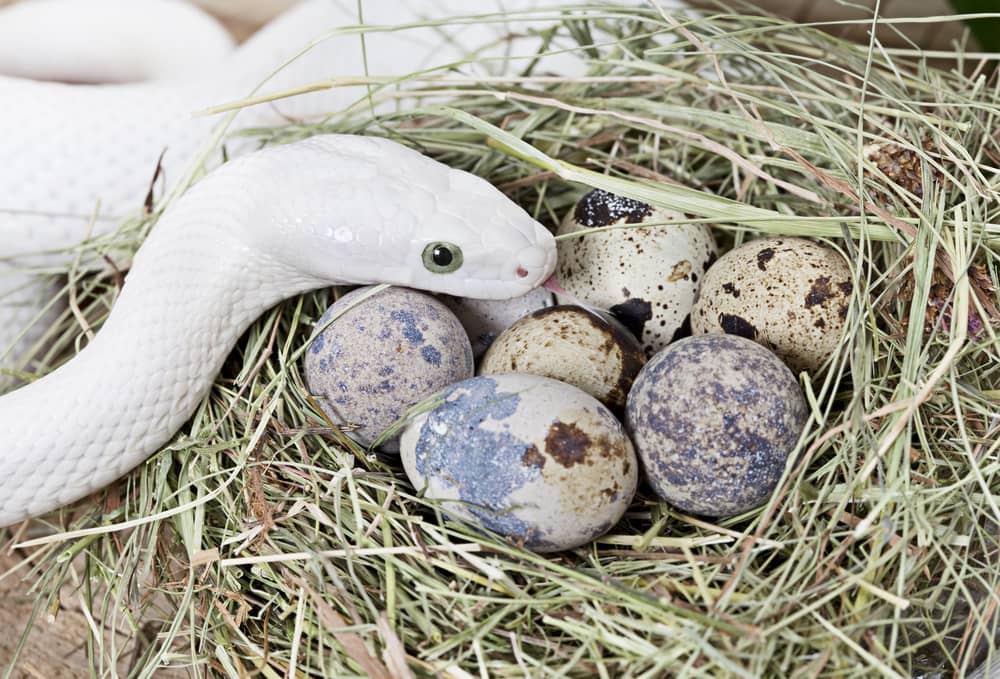
Some species are very protective of their eggs and nest.
In general, it’s best not to tamper with snake eggs, especially if the snake is venomous. Chances are it is near the nest, and you could risk being bitten.

Eggs of snakes take on a long, oblong shape.
They are usually off-white like most other eggs, and almost look like large tic tacs. in some cases.
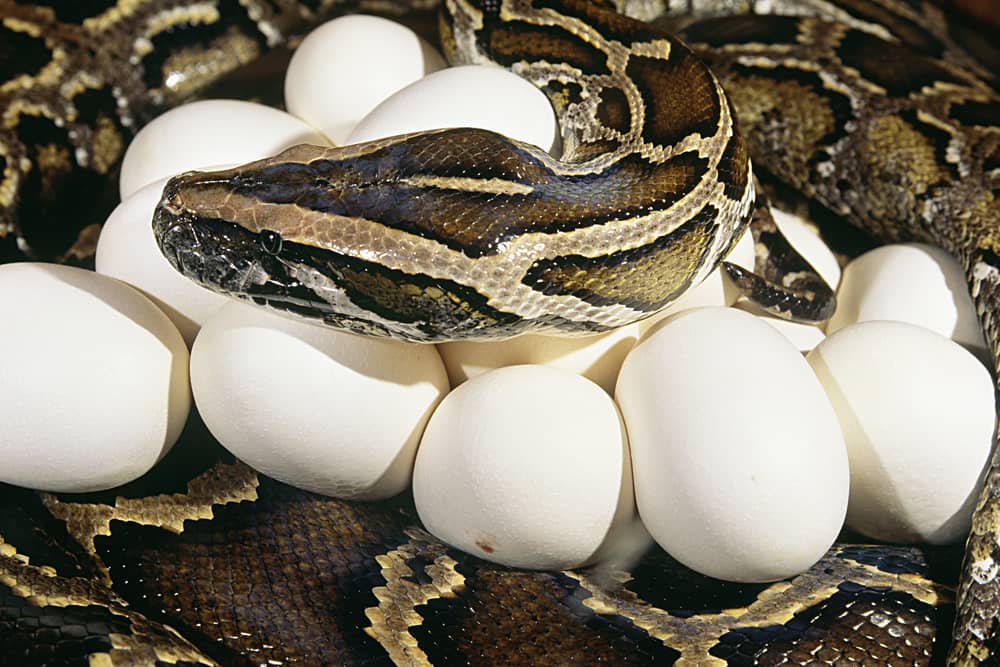
Another example of a snake protecting it’s eggs.
This python mother looks as if she will fiercely protect her unhatched young.
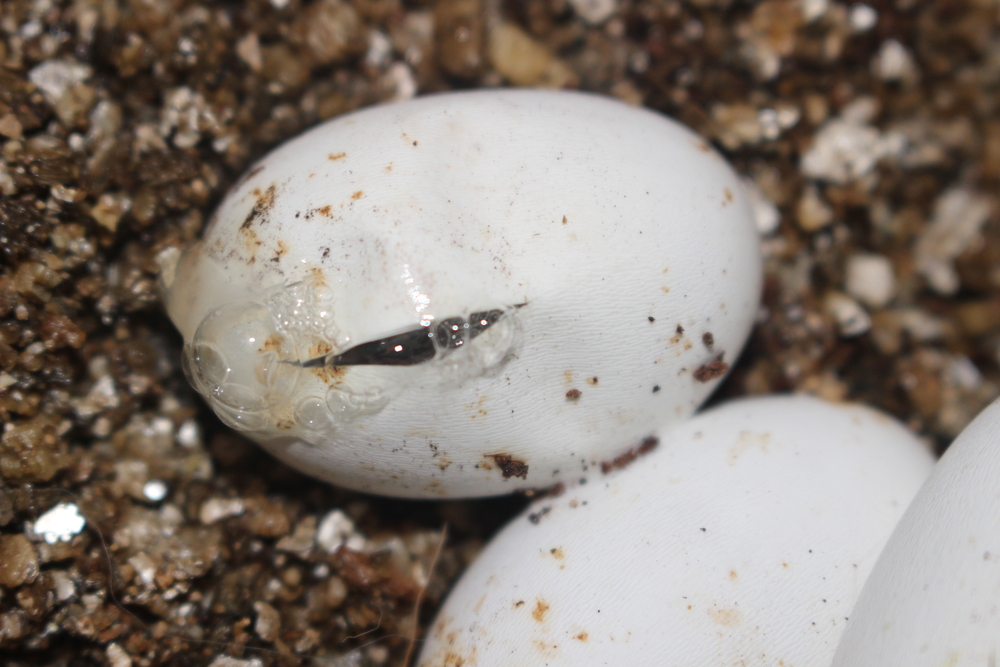
Here’s what a hatching snake egg looks like. The eggs are very soft, so its easy for the babies to get out when hatching.
Unfortunately, the softness means these eggs are also extremely delicate and are more vulnerable.

Check out these two oblong serpent eggs.
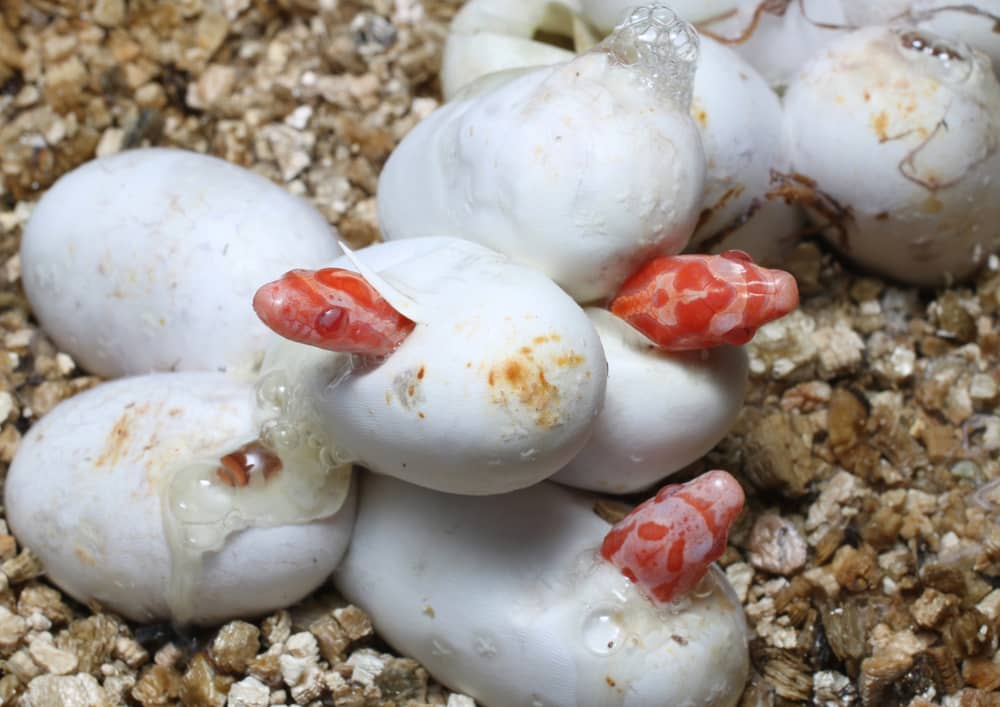
Hatching baby albino corn snakes.
These little fellas look mean, but they are generally harmless. Corn snakes actually make great pets.
Interesting Snake Egg Facts
- A group of snake eggs laid at the same time is called a ‘clutch.’ Clutches can have anywhere from six to one hundred eggs at any time. These groups are much larger than those of birds.
- When it’s time for a baby snake to hatch, it will break the rubbery shell of the egg with its razor-sharp tooth. This tooth is sacrificed for the great escape and falls off once the hatchling comes out of the shell. It is aptly named the ‘egg tooth’.
- As the snake grows within the eggs, so does the egg. This is why you can find small snake eggs that look similar to a very thick grain of rice.
- The soft shell doesn’t do a great job of protecting the embryo. Simply turning it or rolling the egg can harm or kill the embryo.
- Most snakes will hatch in about 60 days. But this can differ slightly depending on the breed.
- Female snakes will look for small dips in the earth to lay their eggs. This offers a warm spot for incubation. If she doesn’t find one, the mother may leave the eggs out in the open, in which case they will die.
- But mother snakes aren’t too concerned about this, most snakes abandon their eggs once they’ve been laid.
- The first thing a newborn does after hatching is stick its tongue out in a bid to ‘taste’ it’s surroundings. In this way, they can collect information using the Jacobson’s organ in their mouths. This is a much more effective way of processing their environment than through their brand new, inexperienced eyes.
- Young snakes hunt and feed immediately after hatching. It’s actually pretty impressive, and scary, how capable the neonatal snakes are at capturing and consuming prey.
- The pliable shell is permeable to gases and liquids but it adequately retains most of its liquid contents unless it is left out in a very dry place.
- Females lay eggs in humid places because the eggs draw water from their surroundings and swell in size. If the egg is left in a dry place, the permeable shell allows water to escape the egg. This causes the egg to shrivel up and the embryo is at risk of dying.
- Snakes of the same species have stimuli that lead them to the same place to hunker down for hibernation. This is also true for laying eggs. Females will deposit their clutch of eggs in the same spot as clutches from other females.
- Snake eggs tend to stick together and you’ll usually come across a clutch of joined eggs in a damp area.
How Much Do You Know About Snake Eggs?
Do you know your reptile from your fowl? A rattlesnake egg from your everyday chicken egg?
Hopefully, this guide has made you a little more confident about identifying a snake egg that you might get lucky and come across.
Remember, the key features are a soft, rubbery shell and texture, and an oblong shape.
If it’s green or blue and soft, then you’ve probably happened upon a ‘rotten egg’. You wouldn’t want to fry one of those up for a snack.
You can handle snake eggs for identifying purposes and if you want to move them off your property. But be gentle and don’t be handsy for too long as they’re pretty fragile and even slight movements can hurt the embryo.
Next time you’re out for a walk, keep your eyes peeled for a clutch of eggs on the ground and test out your new knowledge!
Notable examples of snakes that do not lay eggs are boas, sea snakes, and most vipers. Some give birth to live young and are known as “viviparous”. Others produce eggs that remain in the female’s body until birth. These are known as “ovoviviparous”.
Snake eggs can be difficult to distinguish from eggs of other species, but they do have some key identifying features.
It can be beneficial to know how to identify snake eggs in areas where egg-laying venomous snakes are present.
In This Article
In Short
- Snake eggs can easily be mistaken for those of birds and other reptiles
- Reptile eggs are soft and leathery compared to those of birds
- Snake eggs may be identified by their characteristic, elongated shape
- Snake eggs are typically laid in groups (“clutches”) and may appear stuck-together
- Healthy snake eggs are always white or off-white in color
- It is quite easy to incubate snake eggs, but reptile breeding is a big commitment
- Snake eggs are edible. None are known to be poisonous
How to Identify Snake Eggs
In this section, you will learn how to identify eggs that could belong to a snake.
Snake eggs can be difficult to tell apart from those of other reptiles. The best that can be done – in most cases – is to rule out common lookalikes. This can be done by identifying characteristics not possessed by snake eggs.
Note that some lizards and even turtles can lay eggs that are very “snakey” in appearance.
To quickly identify a clutch of eggs, check out our handy flow chart.

Placement
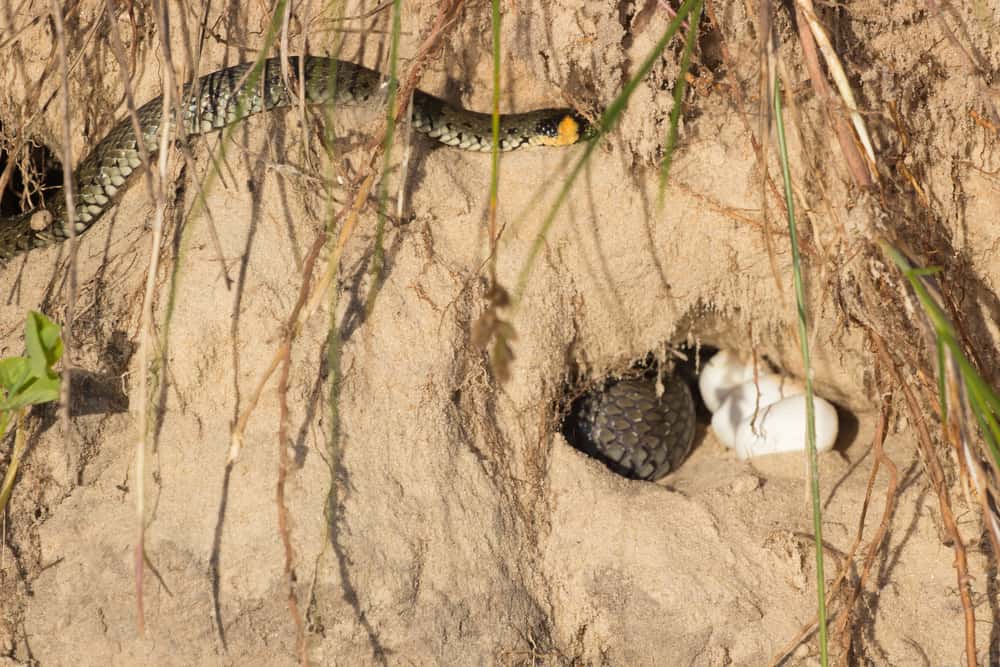
Recall that snakes tend to nest in tucked-away spaces.
Snakes (except for the king cobra) will not build a nest. Instead, they will find a sheltered depression in which to deposit their eggs directly. Snake eggs are usually found in loose dirt or under natural debris.
Other reptile eggs, such as those of turtles and lizards, may be found in similar places.
Clutches of snake eggs are laid very close to one another. Some may even appear stuck together.
Shape
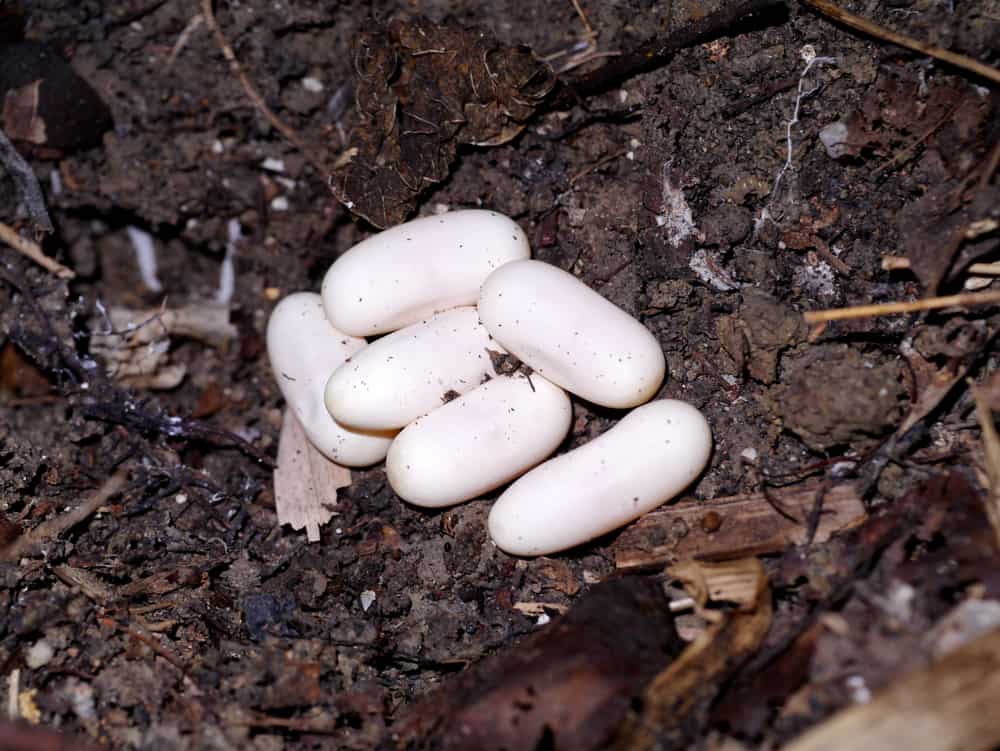
At first glance, reptile and bird eggs can appear similar. Luckily, there are a few key differences to look for.
Most snake and lizard eggs are oval or oblong-shaped and are thinner than bird eggs. This can vary by species. Some snakes do lay eggs that can be similar in shape to a bird’s.
Near-spherical eggs are likely to belong to a turtle, such as a snapping turtle or softshell.
Texture
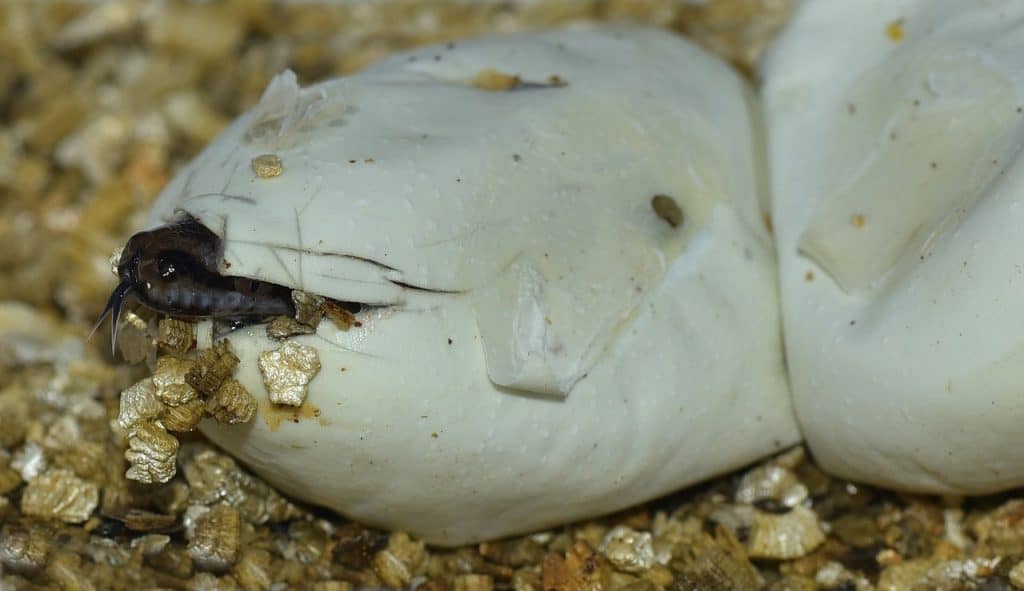
Reptile eggshells are softer and more pliable* than those of birds. They are usually described as feeling soft and somewhat “leathery” or “rubbery”.
*Note: Handling or turning snake eggs can harm the developing embryo. If you do move them, be sure to return them in the exact position in which they were found. Remember that most snakes are harmless and beneficial to the natural ecosystem.
Size
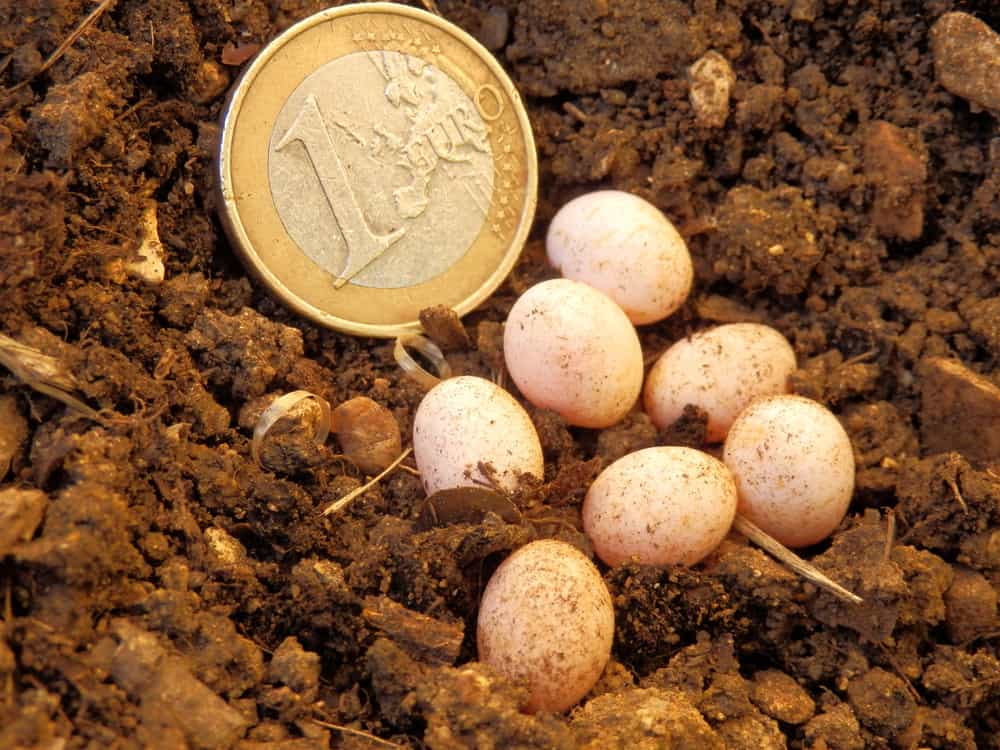
Snake egg size is dependent on maternal body size. Eggs may be as small as a grain of rice, or larger than chicken eggs, depending on the species.
Most snake eggs are between 1 and 5 inches in length.
As a good rule of thumb, oblong-shaped eggs between one and five inches long are probably snake eggs. Eggs smaller than 1 inch probably belong to a lizard.
Color
Reptiles do not lay colorful or speckled eggs like some birds. All snake eggs are off-white in color unless rotten.
Candling (Advanced Technique)
Herpetologists and reptile breeders use a technique called “candling” to identify eggs. Though tricky to learn, this technique can distinguish snake embryos from those of other reptiles.
In a dark room, hold an egg against a targeted light source. Be sure to avoid turning the egg at all costs, as this can kill embryos. The shell should appear translucent, revealing the embryo inside.
All embryos will appear similar to the untrained eye. Snake embryos are typically round in appearance.
Note that it is very difficult for an untrained person to distinguish snake species based on their eggs.
What to Do if You Find Snake Eggs on Your Property
If you find snake eggs in your yard, you may be worried that they present a hazard.
Remember, the vast majority of snakes are harmless to humans.
In North America, most venomous snakes actually give birth to live young. The coral snakes are the only North American species that lay eggs and possess potent venom.
Coral snakes are found only in the following US states:
- Arizona
- New Mexico
- Texas
- Carolinas
- Florida
- Georgia
- South Carolina
- Arkansas
- Louisiana
- Alabama
- Mississippi
North American snake eggs are most likely to belong to a harmless species.
Check with your local wildlife trapper or pest control center if you are concerned. They may be able to help you identify coral snake eggs.If you are looking to hatch some eggs you found, the best thing to do is leave them as they are. Failing that, they need to be placed in an incubator as soon as possible.
In the next section, we’ll learn how to set up a basic incubator and care for snake eggs in captivity.
Snake Reproductive Biology
In this section, we will discuss important aspects of snake reproduction, with a focus on egg-laying species.
Why Don’t All Snakes Lay Eggs?
Producing offspring can be a dangerous and strenuous task for any animal. It pays to have the right strategy for the situation.
Bearing live young can be highly advantageous in the right conditions.
This trait may have helped snakes to colonize colder climates. Live-bearing snakes are far more common in temperate areas. The live-bearing European adder (Vipera berus) can even be found in the Arctic circle!
Reptile eggs must be laid on land in order to survive. Live-bearing snakes such as sea snakes and water snakes can remain in wet habitats year-round. They can even give birth underwater!
Live birth also reduces the need to search for nesting sites and prevents egg predation.
Oviparous snakes benefit from shorter “pregnancies” than their live-bearing counterparts. This allows them to continue to feed and allocate resources to their own growth.Egg-laying species are also able to produce more offspring than live-bearers.
Evolutionary biologists believe that the first reptiles were all egg-layers. Live-bearing methods are thought to have evolved later in groups subject to specific evolutionary pressures.
Fun Fact: The ability to give live birth may have evolved independently in over 30 different snake lineages!
Which Snakes Lay Eggs?
All major snake families contain some oviparous species.
Most colubrids lay eggs, such as rat snakes, king snakes, and hognoses. Water snakes (genus: Nerodia) and garter snakes (genus: Thamnophis) are notable exceptions to this rule.
Elapids – members of the cobra family – are also predominantly oviparous snakes. Live-bearing exceptions include Australasian death adders (genus: Acanthophis) and all but one genus of sea snakes (subfamily: Hydrophiinae).
Most members of the boa family (Boidae) are viviparous. This includes the Boa constrictor, anacondas, and most sand boas.
Fun Fact: Some boa lineages may have “re-evolved” oviparity after being viviparous for millions of years!
All pythons (family: Pythonidae) are oviparous, unlike their closely-related boid cousins.
Ball pythons can lay between 3 and 16 eggs each reproductive cycle.
Check out our ball python eggs guide for more info and answers to additional specific questions.
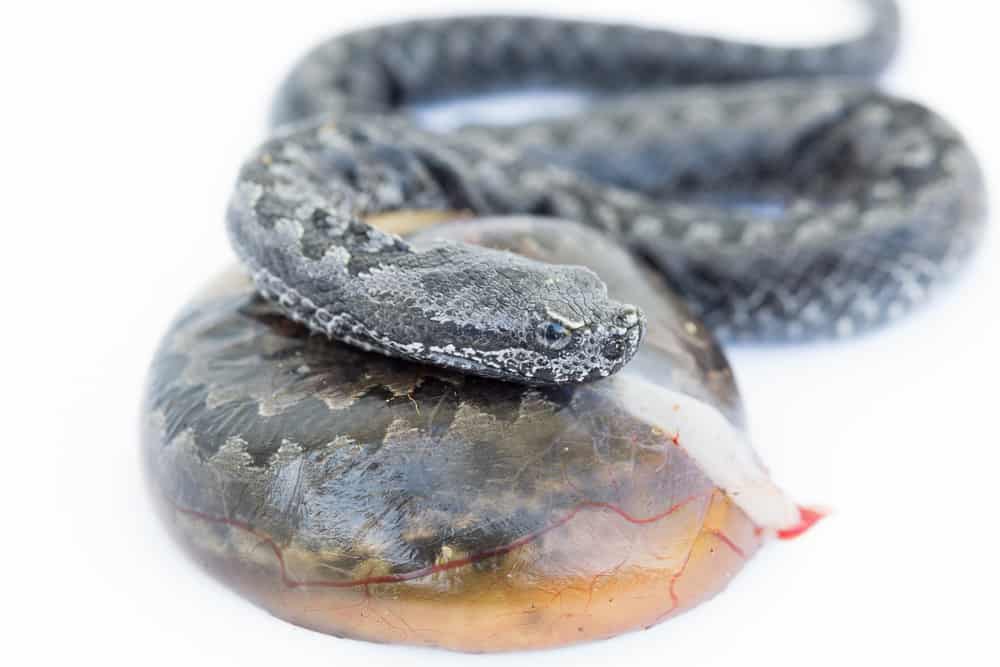
The viper family (Viperidae) contains oviparous and ovoviviparous species. Most of the oviparous species are found in tropical and subtropical climates. Constant temperatures and high humidity are factors that may favor egg-laying.
When do Snakes Lay Their Eggs?
Snakes are able to breed once or twice per year.
There is some degree of seasonality in snake reproduction. This effect is most apparent in temperate species.
Snake embryos – like all embryos – require a constant, warm temperature to properly develop. While they are stuck in an egg, snakes are not able to regulate this by basking.
Because of this, temperate species reproduce during the warmest months.
In North America, snake eggs are typically laid in the early Summer (June – July)
Most eggs will hatch during the late Summer and Fall (August – September).
In tropical climates, this season can be much longer, and some species reproduce year-round.
Where do Snakes Lay Their Eggs?
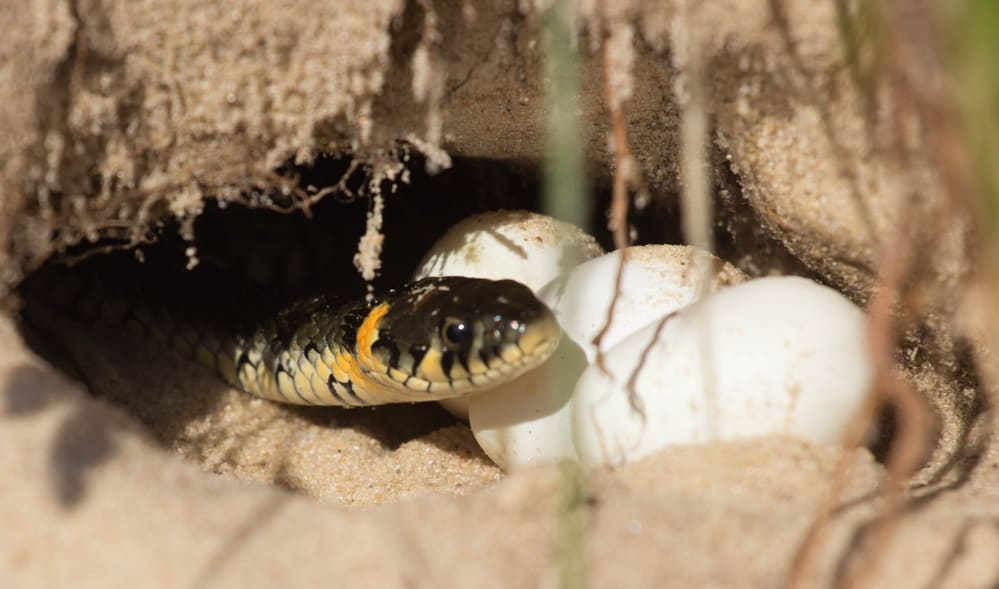
Most snakes use natural cavities to hide their eggs, usually in humid and sheltered spaces.
These often include compost or brush piles, leaf litter, and rotting wood. Some snakes use underground burrows made by other animals to lay their eggs.
Building your own nest box can be a fun way to provide habitat for snakes in your yard or garden!
Fun Fact: The king cobra (Ophiophagus hannah) is the only snake species known to actively build its own nest.
How Many Eggs Can a Snake Lay?
Clutch size is usually related to body size in oviparous snakes.
Small snakes, like colubrids, tend to lay around 10-30 eggs.
The largest snakes, like pythons, can lay over 100 eggs at a time (though usually fewer).
The smallest clutch sizes occur in minute species such as the thread snakes (genus: Leptotyphlops). Adults can be as little as 10 cm in length, and lay only one egg per clutch.
How Long do Snake Eggs Take to Hatch?
Incubation times, like clutch size, vary among species.
57 days is thought to be the average time taken for hatchling snakes to emerge.
Most species fall within the range of 40 to 70 days.
Fun Fact: Snakes can synchronize hatching times using their siblings’ heartbeats.
Do Snakes Protect Their Eggs?
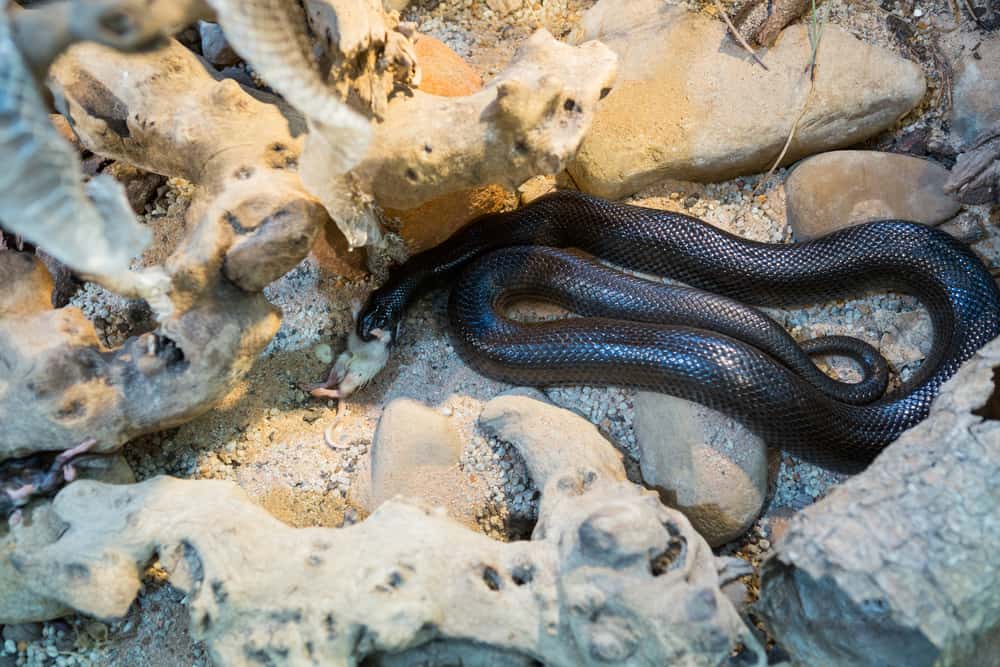
Most snakes move on after laying their eggs and do not return.
Maternal egg guarding is known to be present in only around 3% of oviparous snakes.
This apparent caring behavior is most commonly observed in pythons. Females of certain species coil around their eggs until they hatch. This has been found to help with temperature regulation and to control water and gas exchange.
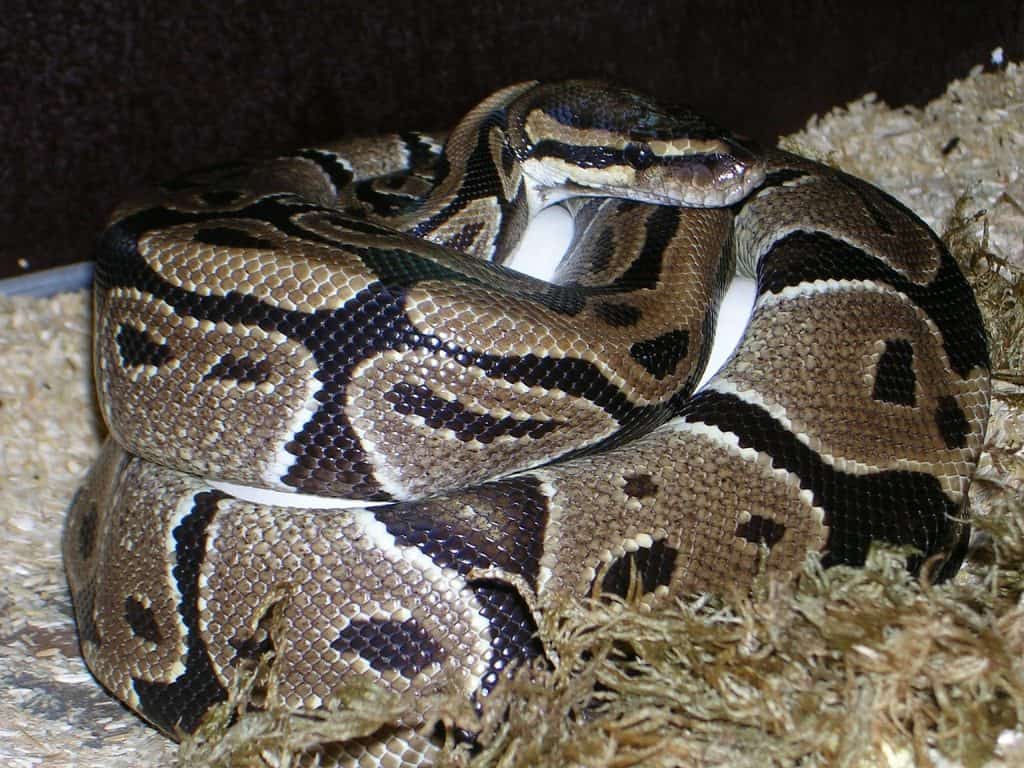
In oviparous species with parental behavior, mothers move on as soon as hatchlings emerge.
However recent evidence suggests that some live-bearing vipers may stay with their offspring until their first shed.
As snake mothers are rarely found alongside their eggs, snake eggs can be tricky to identify.
Caring for Snake Eggs
Though some equipment is required to get started, hatching snake eggs can be fairly straightforward.
The following section should serve as an intentionally basic introduction to snake egg care.
Be sure to thoroughly research the topic before attempting to breed reptiles.
Should I Breed Snakes?
As with any animal, snakes can be a big responsibility.
Breeding snakes – especially large clutches – requires commitment. It is also important to consider how you will care for the hatchling snakes once they emerge.
Breeding reptiles without proper knowledge can lead to neglect and even abuse of the animals.
Many reputable snake breeders sell healthy hatchlings at a reasonable cost. Still, hatching an egg can be a rewarding experience if done correctly.
Incubating Snake Eggs
A basic incubator setup can consist of a plastic container (to hold the eggs). This would then be placed inside of an insulated box, such as a cooler.
It is easier for beginners to purchase a ready-made incubator. These can be found in many reptile stores.
If your incubator includes a fan, disconnect it to prevent water loss.
Make sure that air holes are present and uncovered. These will provide oxygen for your snake embryos as they grow. Briefly open the incubator every few days to provide fresh air.
Many commercial incubators include a water bath to prevent temperature changes. This effect can be achieved using an aquarium heater.
It is important to keep the temperature between 27 and 31 degrees celsius. Some species have more specific requirements, so research is needed ahead of time.
At least two thermometers should be used to monitor temperature at all times. The temperature should be controlled by a thermostat if possible.
Humidity should be kept around 90%.
It is important to run an incubator for a couple of days before adding your snake eggs. This gives it time for desired conditions to be reached.
Your incubator should be kept away from additional sources of heat or cold air. Prevent other disturbances such as strong vibrations.
Place the eggs in the container, partially buried in a suitable substrate, such as soil, vermiculite, or sphagnum moss. Do not place the eggs more than halfway beneath the substrate, or they may suffocate.
Substrate should be lightly misted every few days to maintain humidity. Be careful not to saturate substrate with water.
Eggs should be kept in their original orientation, and never turned. Gently marking the top of each egg with a pencil can help.
Most snake eggs should hatch in 45-70 days if incubated properly.
Taking on any pet is a big commitment. Luckily, caring for a snake is relatively straightforward. Once you understand their needs for heating, lighting, and a healthy diet, it’s like second nature. For further information about snake care, check out our ball python and corn snake care sheets.
Resources For Snake Breeders
There are many books on the topic of snake breeding and egg-care.
The best approach is to search for titles relating to the species you intend to keep. There are too many such titles to list here. You may find some at your local reptile store.
Chris Mattison’s “Keeping and Breeding Snakes” includes information about egg incubation across a range of species.
Micha Petty’s “A Primer on Reptiles and Amphibians” is an excellent book for anyone looking to learn more about herpetology. This title recently featured in our list of top 5 “Must-Read” books about snakes.
Are Snake Eggs Edible?
Surprisingly, snake eggs are edible!
In some Asian cultures, snakes are regularly consumed, along with their eggs.
No snake is known to lay toxic eggs, but allergies and food-borne illnesses can occur as a result of consumption.
Hopefully, this article answers all of your questions about snake eggs. Check out our Florida snakes article to learn more about the eastern coral snake.

Удивительные питомцы Hatchimals сами вылупляются из яйца, "растут" и развиваются. Этим забавным существам просто не терпится оказаться в ваших заботливых руках. Подарите свою любовь и тепло малышам Hatchimals: помогите им вылупиться, согревая и поглаживая яйцо в руках, воспитывайте, обучайте и играйте с ними весь день напролет!
Распаковываем

Ваш Hatchimal был упакован особенно бережно, и не менее важным будет аккуратно его распаковать. Сначала попросите взрослого осторожно разрезать и удалить липкую ленту сверху упаковки. Затем уберите пластиковую крышку, положите коробку набок и подцепите пальцем верхнее отверстие. Теперь не торопясь извлеките внутреннюю коробку с игрушкой из упаковки. Затем попросите взрослого разрезать и убрать липкую ленту, которая крепит блистер к картону. Приподнимите блистер с игрушкой из картонной коробки.
На дне яйца имеется два пластиковых замка. Чтобы убрать их, возьмите один замок двумя пальцами, поверните на 90 градусов по часовой стрелке и вытяните его. Повторите то же самое со вторым замком. Теперь ваш Hatchimal оживает.
Внутри вы найдёте одного из двух Hatchimalов, изображённых на коробке. Вы не будете знать, кто сидит внутри, пока он не вылупится.
До вылупления

Теперь, когда вы достали яйцо из упаковки, вы можете заботиться о нём, пока из него никто не вылупился. Вы услышите, как Hatchimal мило лопочет внутри яйца, а его глаза будут менять цвет, по которому вы узнаете, как он себя чувствует.
Существует много способов помочь вашему Hatchimalу вылупиться. Давайте рассмотрим несколько.
Обнимашки

Hatchimalам нужна любовь и забота. Когда вы держите яйцо снизу, глаза вашего Hatchimalа будут сиять розовым цветом, и вы услышите его сердцебиение. Если глаза засияют голубым и вы услышите замёрзший голос – значит, ему холодно. Потрите яйцо снизу, чтобы согреть его, вот так.
Покачивания

Осторожно возьмите яйцо двумя руками и не торопясь покачивайте вправо-влево. Чем больше вы его качаете, тем лучше будет реакция Hatchimalа. Сначала ваш Hatchimal развеселится, но если вы перестараетесь, у него закружится голова и он огорчится.
Похлопывания

Когда огоньков не видно – ваш Hatchimal прислушивается. Убедитесь, что вокруг достаточно тихо, чтобы он мог вас услышать. Постучите по яйцу – и он постучит в ответ. Вы слышали? Hatchimalы любят стучать в ответ, подстраиваясь под ваш ритм.
Вот ещё несколько подсказок по цвету глаз

Красные глаза означают, что ваш Hatchimal недоволен. Порадуйте его, погладив нижнюю часть яйца.
Оранжевые глаза означают, что вашему Hatchimalу нужно срыгнуть. Помогите ему, осторожно похлопав по нижней части яйца.
Мигающие оранжевые глаза укажут вам на то, что у Hatchimalа приступ икоты. Осторожно постучите по яйцу, чтобы прогнать икоту.
Зелёные глаза означают, что ваш Hatchimal неважно себя чувствует. Потрите яйцо снизу, чтобы он почувствовал себя лучше. Либо наклоните его, чтобы он чихнул.
Синие глаза означают, что ваш Hatchimal напуган. Чтобы успокоить его, потрите яйцо снизу. Но вы можете напугать его ещё больше, постучав по яйцу.
Белые глаза означают, что ваш Hatchimal собрался спать. Разбудите его, немного потерев или покачав.
Вы можете заботиться о яйце постоянно или время от времени. Чтобы Hatchimal начал вылупляться, с ним необходимо поиграть 20-25 минут.
Вылупление

Вылупление бывает только раз в жизни, и каждый Hatchimal уникален. Когда глаза вашего Hatchimalа засияют радужным светом – он будет готов вылупиться! Но не переживайте – он не вылупится без вас. Вот, как ему помочь.
Потрите яйцо снизу, и ваш Hatchimal начнёт проклёвываться. Глаза при этом мигают. Чем больше вы поглаживаете яйцо снизу, тем интенсивнее Hatchimal будет проклёвываться. Если ваш Hatchimal вдруг уснул во время вылупления, положите его, а затем возьмите в руки, чтобы продолжить вылупление.
Когда он разобьёт достаточно много скорлупы, вы можете помочь ему, убрав её кусочки. Вылупление может занять до 30 минут.
Теперь вы можете снять верхушку яйца и остатки скорлупы, которые вам мешают. Затем выньте Hatchimalа со щелчком. Снимите перфорированную пластиковую плёнку, сжимающую крылья. Нажмите на пузико Hatchimalа, чтобы он спел песенку Hatchi Birthday.
Запомните: каждый Hatchimal уникальный, и теперь, когда ваш Hatchimal родился, обязательно выкиньте все кусочки скорлупы.
Младенец

Ваш новорожденный Hatchimal – настоящий младенец, и ему нужно много заботы и любви, чтобы вырасти. Вот несколько советов о том, как заботиться о нём, когда это необходимо.
Поглаживания

Поглаживайте своего Hatchimalа по голове – в ответ его глаза засияют розовым и он заворкует от удовольствия. Продолжайте гладить его по голове, и он скажет: “I love you”.
Кормление

Кормите вашего Hatchimalа, наклоняя его вперёд. Он будет издавать чавкающий звук. Но если он переест, его глаза засияют оранжевым, и ему нужно будет срыгнуть. Если он переест – похлопайте его по голове, чтобы он почувствовал себя лучше. Вскоре ваш малыш Hatchimal выдохнет с облегчением.
Развлечение

Даже младенцы-Hatchimalы любят повеселиться. Жёлтые глаза означают, что ваш Hatchimal готов поиграть. Покачивайте его вниз-вверх, и вы услышите крик Weeee! Продолжайте веселье, пощекотав его по пузику – пусть ваш Hatchimal посмеётся!
Успокоение

Похлопайте его по голове – и он почувствует себя лучше. Но есть и другие способы успокоить вашего Hatchimalа. Например, когда ваш Hatchimal неважно себя чувствует, а его глаза зелёные, вы можете наклонить его вперёд, чтобы он чихнул, или нажать на его пузико, чтобы он покашлял. Есть множество способов позаботиться о вашем Hatchimal-младенце. Изучите инструкцию, чтобы узнать обо всём, что он умеет.
Карапуз

Ваш Hatchimal быстро растёт. Когда она достигнет новой ступени, она засияет радужными глазами и споёт Hatchi Birthday. Настало время научит его ходить, говорить и танцевать!
Учим Hatchimalа говорить

Чтобы научить Hatchimalа говорить, нажмите на его пузико и удерживайте, пока его глаза не засияют бирюзовым, затем он скажет Hello! Теперь скажите что-нибудь и отпустите пузико. Hatchimal повторит то, что вы сказали.
Учим Hatchimalа ходить

Чтобы научить Hatchimala ходить, переключайте меню, пока его глаза не засветятся ярко-белым. Теперь похлопайте его по макушке, чтобы он послушал. Ярко-белый свет означает, что он ждёт команды. Хлопните один раз, чтобы ваш Hatchimal пошёл вперёд. Хлопните дважды, чтобы ваш Hatchimal повернулся. Но осторожно, вы можете вызвать у него головокружение!
Учим Hatchimalа танцевать

Чтобы научить Hatchimala танцевать, переключайте меню, пока вы не услышите танцевальную музыку и его глаза засветятся фиолетовым. Похлопайте его по голове или подождите 3 секунды, чтобы активировать режим танца. Веселье начинается! Когда ваш Hatchimal будет танцевать, похлопайте его по голове и сыграйте барабанный ритм.
Хотите отдохнуть от танцев? Вы можете перевернуть его вверх тормашками, а затем обратно, чтобы остановить музыку. Чтобы снова включить музыку, опять переверните его и поставьте на ноги. Hatchimalы любят веселиться – так что вперёд!
Ребёнок

Поздравляем! Вы вырастили своего Hatchimalа из младенца в карапуза, а теперь он стал ребёнком! Он помнит всё, чему вы его научили. Но теперь у вас появилось четыре игры, которые нужно разблокировать.
Для начала перелистайте меню с помощью нажатий на пузико.
Глупенькие звуки

Чтобы запустить глупенькие звуки, нажимайте на пузико Hatchimalа, пока его глаза не засветятся зелёным. Похлопайте его по голове или подождите 3 секунды, чтобы запустить глупенькие звуки. Ваш Hatchimal будет настукивать ритм. Ваша задача – прохлопать такой же ритм. Если вы повторите 10 ритмов подряд – вы выиграете!

Для игры в Tag пролистайте игровое меню, пока глаза вашего Hatchimalа не засияют красным. Похлопайте его по голове или подождите 3 секунды, чтобы начать игру Tag. Ваш Hatchimal начнёт бегать, меняя цвет глаз. Когда глаза засветятся красным – хлопните по его голове, чтобы отметить это. Если глаза не красные – попытка не будет засчитана. Вам нужно 15 правильных попыток, чтобы выиграть!
Hatchimal говорит

Для игры в «Hatchimal говорит» пролистайте игровое меню, пока его глаза не засияют голубым. Похлопайте его по голове или подождите 3 секунды, чтобы начать игру «Hatchimal говорит». А теперь – внимание! Глаза вашего Hatchimalа будут сверкать разными цветами, которые подскажут, что вам надо сделать. Красный – хлопните по макушке. Розовый – нажмите на пузико. Голубой – наклоните вверх тормашками. Внимание! Чем дольше вы играете, тем быстрее становится игра. Вам нужно не ошибиться 15 раз подряд, чтобы выиграть!
Hatchimal-медиум

А теперь узнайте, умеет ли ВАШ Hatchimal предсказывать будущее. Для игры в Hatchimal-медиум перелистывайте меню, пока его глаза не засияют оранжевым. Похлопайте его по голове или подождите 3 секунды, чтобы начать игру «Hatchimal-медиум». При оранжевом цвете глаз задайте Hatchimalу вопрос с ответом «да» или «нет». Он ответит звуками «Да», «Нет» или «Возможно». Но не забывайте: это просто игра, так что не относитесь к ней слишком серьёзно.
Теперь ваш Hatchimal совсем большой! Но тот факт, что он вырос в большого ребёнка, не означает, что вы не можете вернуться к предыдущем ступеням. В любой момент вы можете перезапустить вашего Hatchimalа и снова сделать его младенцем или карапузом.
Установка батареек

Если глаза вашего Hatchimalа мигают красным и оранжевым – значит, батарейки садятся и их нужно заменить. Чтобы установить новые батарейки, попросите взрослого открыть отвёрткой отсек для батареек. Извлеките старые батарейки и соблюдайте полярность во время установки новых.
После замены батареек, закройте отсек и продолжайте игру!
Включение/выключение/перезапуск/громкость
В яйце

Перезапуск после вылупления

Чтобы перезапустить Hatchimalа в режиме младенца, попросите взрослого включить Hatchimalа и в течение двух секунд подержать нажатой маленькую кнопку перезапуска. Для этого можно использовать скрепку или другой подобный предмет.
Полугромкость после вылупления

Если вам кажется, что ваш Hatchimal слишком расшумелся, вы можете настроить полугромкость. Для начала выключите вашего Hatchimalа. Теперь нажмите и удерживайте пузико, одновременно включая рычажок on/off. Теперь ваш Hatchimal будет работать на половинной громкости до следующего раза, когда вы его включите.
Discord – это не только место для связи, но и платформа, наполненная секретными пасхалками, но как их найти? Расскажем в статье.

Пасхалки в Discord – уникальные функции, которые позволяют открывать секреты и отсылки пользователям. Они добавлены как юмористические дополнения для программных обеспечений.
В статье мы расскажем о том, как найти все известные, на данный момент, пасхалки в приложении Дискорд.
Ремикс рингтона
Во время звонка по Дискорду пользователи смогут услышать ремикс вместо привычного рингтона входящего звонка. Правда такой шанс выпадает один раз на тысячу запусков.
Секретный рингтон нельзя выключить, он будет играть даже после того как вам ответят на звонок.
Секретное комбо
Перейдя в меню с комбинациями клавиш, и введя засекреченную команду, вы сможете лицезреть уникальную анимацию, созданную на основе Shun Goku Satsu из игровой серии Street Fighter.
Для того, чтобы активировать анимацию, необходимо вызвать меню, нажав следующую комбинацию ‘Ctrl+/’ на Linux дистрибутивах и Windows или ‘Cmd+/’ на Macintosh.
Посмотреть анимацию на телефоне – невозможно.
Её появлению способствовал работник Дискорд – Night.
Банан сочувствия
Если вы что-то пытались отыскать, но поиск завершился неудачей, то вы сможете получить знак сочувствия в виде необычного банана. Это происходит абсолютно рандомно.
Разбитая лупа
Если вы что-то пытались отыскать, но поиск завершился неудачей, то вы сможете получить знак сочувствия не только банан, но и разбитую лупу. Это также происходит совершенно рандомно.
Computer Man
Данную секретную пасхалку добавил сотрудник Дискорд – b1nzy.
Змейка (Snake Game)
Именно тут во время нажатия на кнопку консоли перед хомяком-роботом Nelly, активируется игра, она сильно напоминает привычную змейку.
Пасхалка была добавлена одним из разработчиков Дискорд – tcoil.
Комбо-копирования
Если совершить небольшую манипуляцию (нажать на своё имя дважды), то появится знак “скопировано”. Необходимо дождаться, чтобы он исчез, далее повторите нажатие два раза. Появится знак “Двойное копирование!”. После этого необходимо повторять действие до тех пор, пока не высветится подпись красного цвета “БОЛЕЕ, ЧЕМ БОЖЕСТВЕННО!”
Загрузка с звуком
Когда вы включили Дискорд, очень тихим голосом кто-то говорит – “Discord!”, услышать можно не с первого раза.
P.S. Смотрите на пасхалку ниже.
ディスコード
Если пятнадцать раз нажать на кнопку “Главная/Home”, которая находится в верхнем левом углу, то высветится надпись “ディスコード enabled/включено”, и кто-то таинственный произнесёт Diskodo.
P.S Теперь, чтобы услышать звук, и увидеть надпись, необходимо нажать на кнопку несколько раз, но очень быстро.
Синтезатор
Совершите простую комбинацию “Ctrl+/”, и используя стрелки, создавайте собственные мелодичные темы.
Top secret control panel
Нажимая правой кнопки мышки по значку Discord в трее, на самом верху меню (контекстного) можно отыскать специальный пункт, название которого “Top secret control panel”. Разблокировать его нельзя.
Секретная тёмная тема и фонарик
Эту пасхалку можно активировать только в приложении для мобильных устройств Discord на Андроид.
Будьте осторожны – опасно для тех, кто страдает эпилептическими припадками!
Перейдите в настройки внешнего вида Дискорд и много раз жмите на “Тёмную тему”. Тогда активируется опция, она даёт возможность поставить Ну-у-у очень тёмную тему.
Если много-много раз выбирать “Светлую тему”, то экран моментально превратится в ослепительно белый, а на телефоне активируется фонарик. Используйте данную функцию осторожно.
Как видите, Discord – это не только приложение для связи, но и платформа, наполненная секретами и отсылками. Можно поблагодарить разработчиков за то, что они развивают платформу, делая её не только удобнее, но и интереснее, благодаря тайнам.
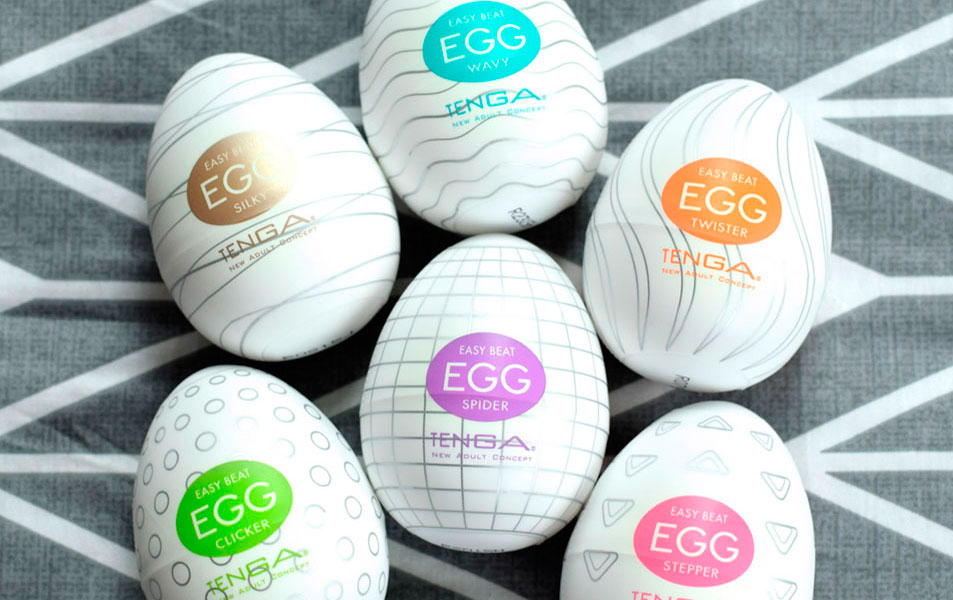
Tenga Egg – это мастурбатор для мужчин, выполненный в форме яйца из нежного материала. Устройство может подарить много разных ощущений и значительно расширить количество доступных экспериментов.
Каждое яйцо имеет раскрывающуюся пластиковую капсулу, немного похожую на Kinder Surprise. Внутри вы найдете пакетик со смазкой, инструкции по применению и мягкое «внутреннее яйцо». Как раз его и нужно использовать для мастурбации. Внутренняя поверхность яйца текстурирована, с различными волнами, выпуклостями, углублениями. Рисунок уникален для каждого яйца.
Тенга Эгг создавалась как одноразовая игрушка. Но некоторые люди используют ее даже по 2-3 раза, прежде чем выбросить.
Как пользоваться Tenga Egg?
Использование Tenga Egg очень простое. Сначала вы должны открыть внешнее яйцо и достать маленькую пластиковую капсулу. Извлеките пакетик со смазкой и нанесите ее на внутреннюю поверхность мягкого яйца. Оно должно быть равномерно покрыто смазкой изнутри.
Маленький пакетик со смазкой напоминает мне о специях в пачках с лапшой быстрого приготовления. Сочетание блестящей фольги с японскими иероглифами заставляет думать как раз об этой пище.
Но вернемся к игрушке. После нанесения смазки вам остается надеть яйцо на член и начать двигать им. Хотя игрушка имеет небольшие размеры, она растягивается, а потому хорошо подходит для разных мужчин. С другой стороны, углубления и выпуклости из-за растягивания могут находиться на расстоянии от чувствительной головки члена.
Честно говоря, я не думаю, что форма яйца идеальна для мужского мастурбатора. Более эффективными мне кажутся игрушки цилиндрической формы. Их не нужно растягивать. Но при этом я хорошо понимаю, что Tenga любит делать необычные игрушки, которые имеют нестандартную форму.
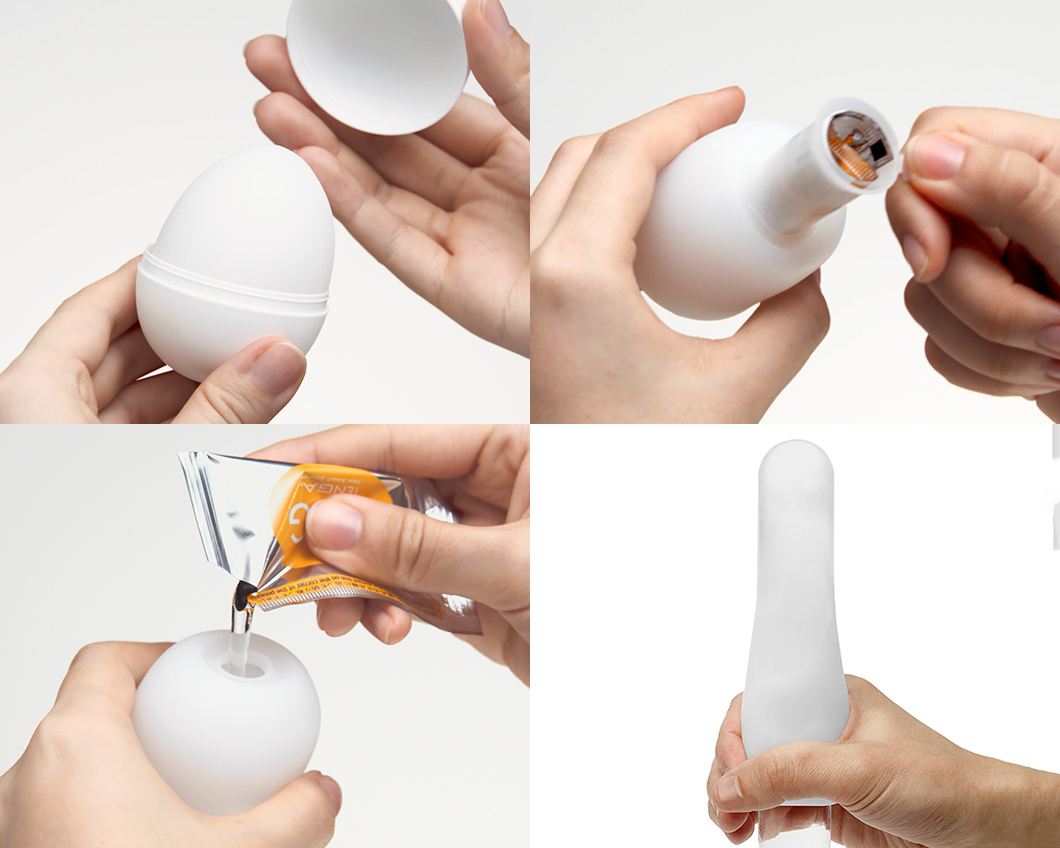
Какое яйцо лучше?
Для этого обзора было заказано два экземпляра Tenga Egg. Это классический вариант Easy Beat и более новая версия Hard-Boiled. В последнем используется специальная смазка для более сильных ощущений.
Оба набора мастурбирующих яиц поставляются в картонных коробках, выглядящих довольно мило. Пакетики со смазкой и руководство пользователя выполнены в одинаковом дизайне.
Компания Tenga действительно хорошо зарекомендовала себя в изготовлении необычных мужских секс-игрушек. Их устройства выглядят интересными и забавными, а не странными. Глядя на коробочку с яйцом, хочется купить себе такое же.
Классический Easy Beat
По моему мнению, Easy Beat является наиболее удачной моделью яйца-мастурбатора Tenga. Хотя гель, который они используют для обработки внутренней поверхности мастурбатора, может показаться слишком нежным, это даже плюс для мужчины. Эластичность яйца вкупе с мягкостью геля позволяют получить приятный опыт мастурбации при разных размерах мужского достоинства.

Stepper
Это яйцо имеет изогнутые волнистые выступы, обращенные в разные стороны. В результате удается получить яркие и в некотором роде неожиданные ощущения.
Clicker
Это одно из моих любимых яиц от Tenga. Оно имеет несколько небольших выпуклостей, которые в определенных точках игрушки концентрируются в гексагональные скопления. Все это немного напоминает соты. Яйцо воздействует на член очень нежно. Но все меняется, если повернуть игрушку так, чтобы выпуклости соприкасались с членом в других местах.
Twister
У этого яйца есть круглые маленькие выступы, расположенные спиралями по всей внутренней поверхности. В целом ощущения довольно обычные, и ничего оригинального во время тестирования я не заметил.
Spider
Как человека с арахнофобией в легкой форме, меня поначалу немного беспокоило название Spider (паук). Оказывается, что внутри яйца узор выполнен в форме паутины. Перекрещенные бороздки обеспечивают весьма интересные ощущения, чувственно массируя уздечку (нижняя часть головки полового члена).
Silky
Еще одна хорошо продуманная текстура. Тонкие линии пересекаются друг с другом подобно плетению шелковой ткани. По ощущениям это, пожалуй, наименее интересное яйцо Тенга. Во время тестирования ничего особенного замечено не было.
Это яйцо имеет волнистый узор из толстых линий. Все это обеспечивает яркие ощущения. Они могут показаться даже чересчур интенсивными для того, чтобы нежно и постепенно дойти до кульминации.
Возможно, некоторые из цветов были указаны не слишком верно. В таком случае извините – автор обзора немного дальтоник. Идентификация цветовой кодировки японских мастурбаторов – та задача, с которой он не сталкивается повседневно.
Рейтинг
Я бы оценил яйца Easy Beat следующим образом:
| Место | Модель | Цвет | Описание | |
|---|---|---|---|---|
| 1 | Spider | Купить | Фиолетовый | Очень приятное воздействие, особенно на нижнюю часть головки пениса |
| 2 | Clicker | Купить | Зеленый | Расслабляющие и разнообразные ощущения в зависимости от положения мастурбатора |
| 3 | Stepper | Купить | Розовый | Интенсивный, но очень приятный |
| 4 | Wavy | Купить | Голубой | Самый интенсивный, возможно, даже чересчур |
| 5 | Twister | Купить | Оранжевый | Рисунок подобран хорошо, но не настолько, чтобы привести меня в безумный восторг |
| 6 | Silky | Купить | Золотистый | Скучно, ничего особенного для меня |
| Купить весь набор | ||||
Я думаю, что компания могла начать с 3-4 отлично продуманных вариантов, а затем просто добавила несколько самых обычных яиц, чтобы сделать большую коллекцию.
Новый Hard-Boiled
Hard-Boiled буквально переводится как «сваренные вкрутую». Следует понимать это так, что яйца воздействуют на пенис более жестко по сравнению с Easy Beat. Здесь используется более плотный гель. Хотя такой вариант мне нравится меньше, чем классика, в линейке Hard-Boiled есть несколько весьма интересных экземпляров.

Thunder
Толстые выступающие линии в форме молний опоясывают всю внутреннюю поверхность яйца. Это может быть приятно, если вы держите мастурбатор в правильном положении, но в целом ничего впечатляющего.
Surfer
Действительно крутой «волновой» рисунок, в котором используется комбинация изогнутых линий с точками разных размеров. Еще ни одно яйцо Тенга не заставляло меня стонать так громко.
Crater
Скучно, скучно и еще раз скучно. Внутренняя поверхность имеет набор углублений, которые немного напоминают лунные кратеры. На вид это довольно интересно, но при этом ярких впечатлений я не получил.
Cloudy
У этого яйца очень сложный узор, который не очень похож на облака (вопреки названию мастурбатора). Лично для меня воздействие этого яйца было слишком интенсивным, и мне даже пришлось остановиться на середине процесса.
Misty
Misty действительно отличается от всех других яиц Tenga. По всей его внутренней поверхности расположено множество остроконечных выступов. Довольно приятное и очень уникальное ощущение.
Shiny
Мне очень понравилось это яйцо благодаря сочетанию выступов разной формы. Если вы держите его правильно, удастся получить яркие ощущения.
Рейтинг
Линейку Hard-Boiled я бы оценил следующим образом:
| Место | Модель | Цвет | Описание | |
|---|---|---|---|---|
| 1 | Surfer | Купить | Синий | Отличные ощущения, бурное семяизвержение |
| 2 | Shiny | Купить | Оранжевый | Хорошо подобранные текстуры для качественного наслаждения |
| 3 | Misty | Купить | Темно-синий | Одна из наиболее необычных текстур |
| 4 | Cloudy | Купить | Фиолетовый | Слишком интенсивно для меня, но многим мужчинам должно понравиться |
| 5 | Thunder | Купить | Бирюзовый | Если держать яйцо под прямым углом, получается довольно неплохо |
| 6 | Crater | Купить | Коричневый | Скучное яйцо, которого следует избегать любой ценой |
| Купить весь набор | ||||
Подведем итоги
В целом, я бы порекомендовал классические Easy Beat для любителей поэкспериментировать с мастурбированием. Яйца Spider и Clicker особенно хороши, но пенис каждого мужчины любит что-то свое. Как знать – вам может понравиться и Crater.
Если вам нужен мой совет, отдавайте предпочтение классической серии Tenga Easy Beat и получайте удовольствие с этими замечательными японскими секс-игрушками.
Читайте также:

